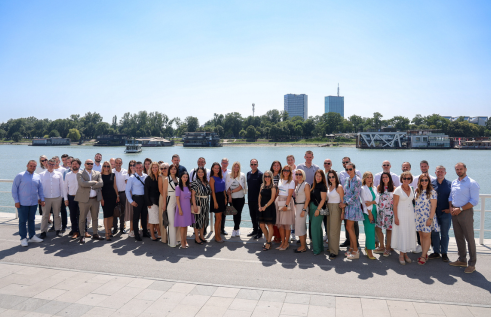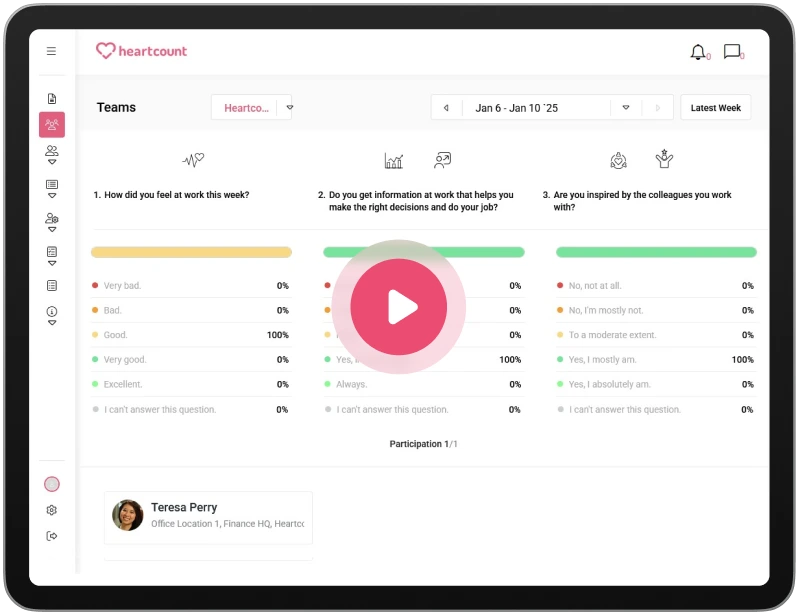Creating a modern organizational sustainability strategy 2025

Organizational sustainability isn’t optional – it’s essential. Businesses can highlight sustainability to attract investments, improve reputation, drive innovation, and meet regulations.
Building a sustainable future benefits both the company’s bottom line and the society.
Organizational sustainability isn’t optional – it’s essential. Businesses can highlight sustainability to attract investments, improve reputation, drive innovation, and meet regulations.
Building a sustainable future benefits both the company’s bottom line and the society.
What is organizational sustainability?
Organizational sustainability enables businesses to serve stakeholders and society while remaining profitable.
It’s both a responsibility and an opportunity. It helps the organization achieve business success while contributing to global progress. This involves integrating sustainable practices into business strategies, ensuring long-term viability, minimizing environmental impact, and creating positive social contributions.
The importance of organizational sustainability
Sustainability is essential for long-term success. It aligns business goals with economic viability, social responsibility, and environmental stewardship.
This creates value not only for the organization but also for stakeholders and society. It ensures long-term business success and addresses environmental, social, and governance challenges.
Organizational sustainability helps companies:
- Meet stakeholder expectations
Stakeholders (customers, investors, employees) are growingly looking for businesses that put sustainability first. This approach builds trust, loyalty, and better relationships with stakeholders.
- Future-proofing
Integrating sustainable practices and ensuring long-term operational resilience can help organizations limit risks related to regulatory, climate, and resource scarcity.
Tiago Pita, Brand and eCommerce Director at retail company Whole Food Earth, says:
“By integrating sustainability into business models, organizations can unlock long-term value, attract investors, and build stronger relationships with customers. Sustainability is key to fostering innovation, managing risks, and ensuring resilience against future challenges.
Prioritizing ESG leads to a healthier work environment, increased employee satisfaction, and a stronger reputation—vital ingredients for long-term success. A sustainable business model drives both profitability and positive social impact, creating a competitive edge that today’s consumers increasingly demand.”
- Operational effectiveness
Energy efficiency, waste reduction, and other sustainability practices help organizations improve their operational effectiveness and lower costs.
- Increase competitive advantage
Organizational sustainability puts your business ahead of competitors by showcasing innovation and a commitment to a greater purpose.
- Attracting investments
Investors are more and more drawn to companies that prioritize long-term sustainability.
Michael Schmidt, Senior Financial Analyst at Kredite Schweiz states:
“I see organizational sustainability as a magnet for modern investors, since it shows long-term vision. Investors today are looking beyond profit; they want to see a company’s commitment to resilience. A strong sustainability program reduces risks—financial and operational—and that builds confidence. It’s no longer just an ethical choice; it’s a smart financial strategy.”
- Attracting talent
The same goes for talent, who also look for organizations with similar values.
- Reducing employee turnover
In addition to attracting top talent, sustainability helps organizations reduce employee turnover by aligning business goals with their workforce.
- Addressing global challenges
Aligning business goals with global efforts is the key to a sustainable future, so organizations must vigorously address issues like social inequality, climate change, and resource depletion.
For instance, Unilever’s Sustainable Living Plan (USLP) outlined the company’s comprehensive sustainability strategy between 2010 and 2020. The strategy was crucial in enabling Unilever to achieve significant results, such as sustainably sourcing 67% of agricultural raw materials by 2020, developing innovative products that reduce energy and water use, such as no-rinse conditioners, or sourcing 100% of grid electricity from renewable sources by 2020.
- Regulatory compliance
Finally, organizational sustainability helps companies ensure compliance and avoid penalties, especially given the increasing environmental, social, and governance(ESG) regulations.
Of the 5,800 companies that participated in one 2024 sustainability report, 79% reported on sustainability, including 96% of the 250 largest companies in the world.
COLLECT
Key trends driving sustainability growth
Sustainability has become the key to long-term organizational success. Every year, executives increasingly understand this and double their efforts to create and follow a sustainability plan.
Between 2023 and 2024, the percentage of executives who stated their investments in sustainability for the next 12-18 months is “likely” to increase” has grown from 33% to 52%, while the percentage of those who said it’s likely to decrease dropped from 28% to 14%.
| Percentage of executives intending to increase or decrease sustainability investments between 2023 and 2024 | ||
| 2023 | 2024 | |
| Likely to decrease | 28% | 14% |
| Likely to stay the same | 38% | 34% |
| Likely to increase | 33% | 52% |
Here are the key trends in driving and shaping sustainability growth:
- Refined regulatory compliance and standardization
Sustainability reporting moves from voluntary to mandatory due to reporting frameworks such as the US Securities and Exchange Commission’s (SEC) Climate Disclosure Rules and the EU’s Corporate Sustainability Reporting Directive (CSRD).
- Focus on net-zero commitments and decarbonization.
Organizations steadily focus on investing in renewable energy sources and reducing their carbon footprint by achieving net-zero emissions. The UN’s ‘Race to Zero’ campaign aims to halve global emissions by 2030.
- Investing in ESG data management solutions
Businesses are investing in ESG data management platforms to comply with the new mandatory sustainability reporting requirements and facilitate efficient data collection, analysis, and reporting. In one survey, 85% of executives said they plan to increase ESG investments in the next five years.
- Advanced technologies integration
Organizations are progressively adopting new and advanced technologies, such as AI, machine learning, cloud computing, and IoT, to improve their sustainability efforts. A Fujitsu-Oxford Economics joint survey found that 76% of business leaders believe digital transformation will assist in their sustainability transformation success.
- Increased transparency
Companies must provide transparent, credible, and inaccessible information regarding their sustainability efforts. Different legislative measures, such as the Green Claims Directive, compel them to corroborate their environmental claims and avoid greenwashing.
- Attention to a circular economy
The push for a circular economy for plastics is in effect. With 175 countries already supporting a global treaty to end plastic pollution, organizations must focus on designing products that significantly reduce plastic waste and its environmental impact.
Tips for creating a modern sustainability strategy for 2025
Creating a modern sustainability strategy requires an organization’s forward-thinking approach that aligns its goals with the ESG priorities.
This strategy involves:
- Clearly defining your goals
The organization’s sustainability vision must be aligned with the business’s mission. This includes:
- Identifying main sustainability challenges, including
- Environmental: climate change, plastic, and waste management, resource depletion..,
- Social: labor rights, health, and well-being, access to education…,
- Economic: financial sustainability, supply chain sustainability, corporate accountability…, and
- Governance challenges: corporate resistance to change, insufficient regulations…)
- Setting specific, measurable, achievable, relevant, and time-bound (SMART) goals. For instance, “reduce carbon emissions by 75% by 2035”.
- Perform thorough materiality assessments.
This assessment allows an organization to identify and spotlight which sustainability issues are the most important for stakeholders. This includes:
- Engaging stakeholders to understand their sustainability priorities
- Using ESG frameworks to steer the materiality assessment
- Focusing on high-priority issues based on their impact and importance
- Benchmarking against industry
Adopting industry benchmarks enables organizations to measure better and enhance their sustainability performance.
For instance, the UN’s Responsible Banking – Priorities and Blueprint for a Sustainable Future provides benchmarks and guidelines for the finance industry.
- Researching and understanding sustainability initiatives and practices performed in your industry
- Identifying key practices, technologies, and innovations
- Fine-tuning and distinguishing the organization’s strategy
- Adopting a data-driven approach
Every step toward achieving sustainability goals is data-driven. This includes:
- Evaluating the organization and social impact
- Investing in data-management tools to track sustainability metrics
- Creating a roadmap with short, medium, and long-term goals
- Integrating organizational sustainability across the organization
Sustainability must be incorporated into every facet of the organization to bring results. This includes:
- Involving all departments (production, HR, marketing, sales, finance, R&D, etc.) into sustainability planning
- Creating and updating policies that emphasize the organization’s sustainability priorities
- Creating awareness, educating, and training employees to integrate sustainability practices into everyday tasks.
- Leveraging innovation and new technologies
Use new technologies and innovation to drive and optimize the organization’s sustainability endeavors. This includes:
- Monitoring resource use and supply chain optimization using AI and IoT tools
- Designing products for reuse and recycling by adopting circular economy principles
- Achieving supply chain transparency and traceability using blockchain technology
- Collaborating with stakeholders
Stakeholder buy-in is essential for successful sustainability initiatives. This requires:
- Regular communication with stakeholders about the organization’s sustainability goals, progress, and challenges
- Partnering with industry groups, NGOs, and government agencies relevant to your industry to augment sustainability impact
- Inspiring employees and customers to participate in sustainability efforts
- Transparency in communicating sustainability
Building trust with stakeholders often relies on your ability to demonstrate accountability. This includes:
- Publishing regular sustainability reports
- Sharing real-time updates on sustainability initiatives’ progress
- Transparency regarding sustainability challenges
- Monitor, evaluate, and improve
Finally, be prepared for emerging challenges and seize opportunities. This means:
- Having clear sustainability KPIs and reviewing progress against them
- Refining sustainability strategies using stakeholder feedback and staying up-to-date for new trends, technologies, and regulations
How to measure and track sustainability progress?
Monitoring sustainability progress requires using tools and technology tailored to the organization’s seeds. Such tools assess ESG metrics and help organizations track progress, identify areas for improvement, and ensure compliance.
Here are some key tools to measure sustainability:
Environmental measurement tools
Leadership in energy and environmental design) The certification is the most prominent global green building rating system, providing a framework for healthy, efficient, and cost-saving green buildings. As of 2024, it is recognized in 186 countries and territories and includes 197,000 projects.
Social and governance tools
The SA8000 standard and certification system provide a framework for organizations to conduct business just and decently for employees and demonstrate their dedication to the highest social standards.
Circular economy tools
The TRUE (total resource use and efficiency) zero waste scorecard provides sustainability scores for companies across sectors.
General sustainability measurement tools
The Sustainability Accounting Standards Board (SASB) is a nonprofit organization founded in 2011 to establish sustainability accounting standards. It helps organizations communicate pertinent sustainability information to their investors.
The Global Reporting Initiative (GRI) standards provide guidelines for good sustainability across industries and help organizations be transparent in their sustainability reporting by divulging their social, economic, and environmental impact.
The Carbon Disclosure Project (CDP) is an NPO that helps organizations report data on carbon emissions, water usage, and forest-related issues.
Measuring and tracking sustainability
Organizations can accurately measure and track their sustainability progress using these metrics:
Environmental metrics
Environmental metrics show how an organization interacts and impacts the natural environment and help measure its sustainability efforts and compliance with environmental regulations:
- The carbon footprint measures total greenhouse gas emissions, including direct and indirect emissions from purchased energy across the value chain. 56% of European organizations have a defined sustainability initiative that includes carbon footprint tracking
- Energy efficiency represents the company’s use of energy resources relative to production output or revenue.
- Water usage assesses total water consumption and its use efficiency
- Waste management displays waste reduction and recycling rates
- Resource efficiency includes the materials used per unit of output and the use of sustainable and recyclable materials
Social metrics
Social metrics focus on the organization’s relationship with the people, including employees, customers, and the community.
- Employee engagement covers employee satisfaction, loyalty, and motivation, all affecting employee turnover and productivity.
- Diversity and inclusion represent employee diversity across race, gender, ethnicity, or other demographics.s
- Community engagement displays the organization’s contributions toward local communities through volunteer programs or investments.
- Training and development track how employees grow through training programs.
- Health and safety track the workforce’s health and safety from incidents and injuries.
Governance metrics
Governance metrics evaluate how well an organization is governed, its leadership practices, regulatory compliance, and transparency.
- Ethics and compliance indicate the effectiveness of governance policies and track compliance breaches and ethical violations.
- Board diversity measures the representation of minority or underrepresented groups on the board.
- Transparency reflects the organization’s openness regarding its ESG disclosures and their quality and frequency.
- Supply chain management ensures that the company’s suppliers follow ethical practices.
Additional KPIs
Additional KPIs are all other metrics not included in environmental, social, or governance.
- Stakeholder satisfaction assesses stakeholder (customer, employee, investor, etc) satisfaction with sustainability efforts through feedback or surveys.
- Sustainable products and services measure the revenue from sustainable products and services.
- Benchmarking against industry standards compares the organization’s ESG performance against industry standards.
The McGrady Clark Retail Sustainability Outlook 2024 provides benchmarks for retailers looking to align business growth with environmental responsibility.
Driving sustainability forward
By integrating sustainable practices, companies can align their operations with stakeholder and community expectations while ensuring profitability. The benefits of this are far-reaching. From reducing risk, optimizing operations, and attracting top talent to gaining a competitive edge.
Key metrics like carbon footprint, energy efficiency, and waste reduction assess the business’s environmental impact, while social and governance metrics ensure it prioritizes employee well-being and ethical leadership.
Finally, developing a strong sustainability strategy begins with clear goals, performing materiality assessment, benchmarking against industry standards, and leveraging tools and technologies.
Ready to drive your business forward? Sign up for a free trial to discover how HeartCount can help you achieve organizational sustainability.









